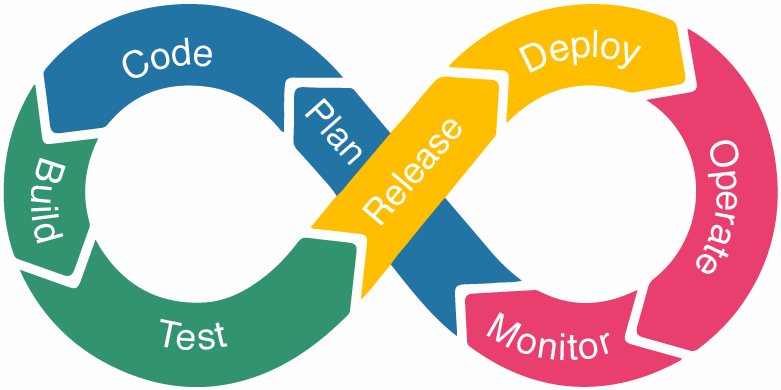What is devops?
Devops is a culture to collaborate between development team and operation team. The primary goal of DevOps is to shorten the software development lifecycle, deliver high-quality software continuously, and enhance the overall efficiency of the development and operational processes.
Devops Life cycle and its tools
The DevOps lifecycle represents the stages and processes involved in developing and delivering software in a collaborative and automated manner. It encompasses the entire software development process, from planning and coding to testing, deployment, and monitoring.

Here's an overview of the DevOps lifecycle:
Plan:
Objective: Define the goals, scope, and requirements of the software development and deployment process.
Activities:
(a). Collaborate between development, operations, and other stakeholders to set objectives.
(b). Plan sprints, releases, and prioritize features.
Tools: Azure Board, Git Wiki, Jira, Trello, Asana, etc.
Code:
Objective: Develop and write the code for the software based on the defined requirements.
Activities:
(a). Developers work on writing code and collaborate using version control systems (e.g., Git) to manage changes.
(b). Code is reviewed to ensure quality and adherence to coding standards.
Tools: Git, GitHub, GitLab, Bitbucket, etc.
Build:
Objective: Compile the source code into executable code or artifacts.
Activities:
(a). Automated build processes are triggered to compile code and create deployable artifacts.
(b). Integration with continuous integration tools ensures that each code change is built and tested automatically.
Tools: Jenkins, CircleCI, TravisCI, etc.
Test:
Objective: Validate the functionality, performance, and security of the software.
Activities:
(a). Automated testing, including unit tests, integration tests, and functional tests, is performed to identify issues early in the development process.
(b). Continuous testing ensures that the software is consistently validated throughout the lifecycle.
Tools: JUnit, Selenium, Pytest, etc.
Release:
Objective: Deploy the software to different environments, such as development, testing, staging, and production.
Activities:
(a). Automated deployment processes ensure consistent and reliable releases.
(b). Continuous Delivery (CD) or Continuous Deployment (CD) pipelines manage the deployment of applications to various environments.
Tools: Ansible, Chef, Puppet, etc.
Deploy:
Objective: Install and configure the software in the target environment.
Activities:
(a). Automated deployment scripts and tools are used to install and configure the software on servers or cloud environments.
(b). Rollback mechanisms are in place to handle deployment failures.
Tools: Docker, Kubernetes etc.
Operate:
Objective: Manage and monitor the deployed applications and infrastructure.
Activities:
(a). Continuous monitoring of application performance, logs, and infrastructure health.
(b). Incident response and resolution, ensuring the system is stable and available.
Tools: ELK Stack (Elasticsearch, Logstash, Kibana), Nagios, etc.
Monitor:
Objective: Continuously monitor application and infrastructure performance.
Activities:
(a). Collect and analyse data related to application and system performance.
(b). Use monitoring tools to detect issues, analyse trends, and plan for future improvements.
Tools: Grafana, Prometheus, Splunk, etc.
The DevOps lifecycle is iterative and emphasizes continuous improvement. It encourages collaboration between development, operations, and other teams, as well as the automation of repetitive tasks to achieve faster, more reliable software delivery. Continuous feedback loops and a proactive approach to addressing issues are key principles in the DevOps lifecycle.
What is Automation, Scaling, Infrastructure
Automation, scaling, and infrastructure are key concepts in DevOps that contribute to efficient and reliable software development and deployment processes.
Automation: Automation is the use of technology to perform tasks without manual intervention. In DevOps, it's about automating repetitive and time-consuming processes to increase efficiency, reduce errors, and speed up software delivery.
Scaling: Scaling involves adjusting the capacity of your infrastructure to handle changes in workload. It ensures that systems can handle increased demand without sacrificing performance or reliability.
Infrastructure: Infrastructure refers to the foundational technology and resources required to run applications. In DevOps, there's a trend towards managing and provisioning infrastructure programmatically.
In summary, automation is about using tools and scripts to perform tasks automatically, scaling involves adjusting resources to handle varying workloads, and infrastructure encompasses the underlying technology that supports the deployment and operation of software. These concepts are interrelated and crucial for achieving the goals of speed, reliability, and efficiency in DevOps practices.
Why DevOps is Important?
DevOps is important for several reasons :
Faster Time-to-Market: DevOps emphasizes automation, continuous integration, and continuous delivery, reducing the time it takes to move from code development to production deployment.
Improved Collaboration: DevOps breaks down silos between development and operations teams fostering a better communication and collaboration.
Enhanced Quality and Reliability: Continuous testing and automation catch bugs early, leading to higher software quality and more reliable releases.
Increased Efficiency and Productivity: Automation of repetitive tasks and streamlined processes reduce manual effort and increase overall efficiency.
Scalability and Flexibility: DevOps practices, such as infrastructure as code and containerization, enable easy scaling and adaptability to changing requirements.
Risk Mitigation: Continuous monitoring and feedback identify and resolve issues early, reducing the risk of critical failures.
Cost Savings: Automation and efficient resource utilization contribute to cost savings in software development and operations.
Improved Security (DevSecOps): Integrating security practices throughout the development lifecycle enhances the overall security of software environments.
Cultural Transformation: DevOps promotes a cultural shift towards collaboration, shared responsibility, and continuous learning.